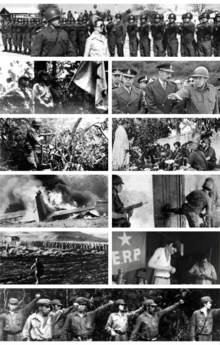Operativo Independencia
| Operativo Independencia | |||||||
|---|---|---|---|---|---|---|---|
| Part of Part of the Dirty War | |||||||
 |
|||||||
|
|||||||
| Belligerents | |||||||
|
|
|||||||
| Commanders and leaders | |||||||
| Acdel Vilas Antonio Domingo Bussi |
|
||||||
| Strength | |||||||
| 5.000 (1975) |
ERP:
Montoneros:
|
||||||
| Casualties and losses | |||||||
|
~70 killed
|
~312 guerrillas killed Hundreds missing |
||||||
ERP:
Montoneros:
~70 killed
(including accidents)
Operativo Independencia (Spanish for "Operation Independence") was the code-name of the Argentine military operation in the Tucumán Province, started in 1975 to crush the ERP —Ejército Revolucionario del Pueblo or People's Revolutionary Army—, a Guevarist guerrilla group, which tried to create a Vietnam-style war front in the Tucumán Province, in northwestern Argentina. It was the first large-scale military operation of the Dirty War.
After the return of Juan Perón to Argentina, marked by the 20 June 1973 Ezeiza massacre which led to the split between left and right-wing Peronists, and then his return to the presidency in 1973, the ERP shifted to a rural strategy designed to secure a large land area as a base for military operations against the Argentine state. The ERP leadership chose to send Compañía de Monte Ramón Rosa Jiménez to the province of Tucumán at the edge of the long-impoverished Andean highlands in the northwest corner of Argentina. By December 1974, the guerrillas numbered about 100 fighters, with a 400-person support network, although the size of the guerrilla platoons increased from February onwards as the ERP approached its maximum strength of between 300 and 500 men and women. Led by Mario Roberto Santucho, they soon established control over a third of the province and organized a base of some 2,500 sympathizers. The Montoneros' leadership was keen to learn from their experience, and sent "observers" to spend a few months with the ERP platoons operating in Tucumán.
...
Wikipedia
